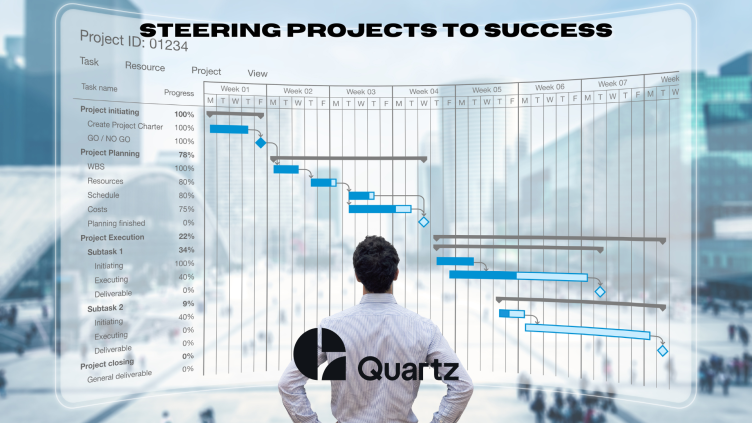Steering Projects to Success: The Critical Role of PMO and Governance
February 6, 2024
Project Management

Organisations rely on projects to drive innovation, transformation, and growth. However, executing projects is easier said than done. PMI’s Pulse of the Profession report shows that only 29% of projects meet their original goals and business intent. This alarming statistic underscores the need for robust project management frameworks to boost project success rates. This is where Project Management Offices (PMOs) and sound governance structures come into play.
The Power of PMOs
A PMO is a centralised unit that oversees managing projects across an organisation. PMOs enable consistent, efficient, and effective project delivery by providing standards, methodologies, tools, and expertise.
A well-structured PMO delivers the following advantages:
- Promotes project management best practices: Standardising processes, templates, and tools across projects minimises variability and creates economies of repetition.
- Offers training and mentoring: Helps project teams enhance their skills through coaching, workshops, and communities of practice.
- Provides oversight and guidance: Monitor projects, identifies issues, and guides teams toward resolution.
- Enables knowledge management: Captures lessons learned and shares expertise across the organisation.
- Optimises resources: Helps allocate skilled resources to suitable projects based on priorities.
- Fosters collaboration: Breaks down silos and enhances coordination between project teams, functions, and leadership.
- Enhances visibility: Through dashboards and reporting, gives leadership visibility into project health and performance.
Robust Governance for the Win
While PMOs provide the scaffolding, governance supplies the blueprint for project success. Effective Governance establishes:
- Clear roles and responsibilities: Define accountabilities to avoid ambiguity and confusion.
- Decision-making framework: Lays out protocols for project-related decisions at Steering Committees, tollgates, etc.
- Risk management processes: Specifies how risks are identified, analysed, and controlled throughout projects.
- Performance metrics: Identifies KPIs to track and measure project success and PMO effectiveness.
- Change control processes: Dictates how changes in scope, schedule, and resources are managed post-planning.
With these elements in place, governance guides projects from inception to closure.
The Winning Combo: PMO and Governance
PMOs and governance provide the structure and discipline required to run projects like a well-oiled machine. Here are some of the key benefits of this synergistic partnership:
- Higher probability of project success: A significant boost in projects coming in on time, on budget, and meeting objectives
- Increased ROI: Through standardisation, oversight, and best practice adoption.
- Better resource management: Enables optimised utilisation and assignment of scarce and critical resources.
- Improved portfolio performance: Higher aggregated returns across the project portfolio.
- Enhanced organisational agility: Faster and more effective response to change.
- Higher customer satisfaction: More predictable and reliable delivery leads to happy customers.
Forging the Ideal Framework
While PMOs and governance provide the foundation, the ideal structures are tailored to the organisation’s needs. Key considerations include:
- Maturity level: Less mature organisations may need a more directive PMO to instil rigour, while mature groups can employ a more flexible approach.
- Culture: The solution must align with existing cultural norms to gain agreement and adoption.
- Size and complexity: More projects and interdependencies require considerable coordination and control.
- Industry dynamics: Fast-changing industries like tech benefit from agile PMO and governance models.
The Journey of Excellence
Implementing PMOs and governance involves cultural and behavioural change. It requires rallying people across the organisation around a shared vision. Investing in capability building, demonstrating value iteratively, and soliciting feedback can lay the foundations for long-term success.
The journey won’t always be smooth. There will be bumps in the road as mindsets and processes transform. However, with patience and commitment, PMOs and governance structures can steer organisations to project management excellence. Teams will function more cohesively, executives will have more confidence in outcomes, and collectively, a business will be empowered to achieve strategic goals through superior project execution.
Key Takeaways:
- A capable PMO and robust governance provide the bedrock for project success.
- PMOs promote consistency, oversight, and collective learning across projects.
- Governance supplies the decision rules and controls to keep projects on track.
- Together, they boost capability, instil rigour and discipline, and raise productivity.
- Tailor models according to the organisation’s maturity, culture, size, and industry.
- Success requires executive sponsorship, change management, and continuous improvement.
By leveraging PMOs and governance as a dynamic duo, organisations can gain a significant competitive edge in delivering projects on time, within budget, and with the intended business benefits.
